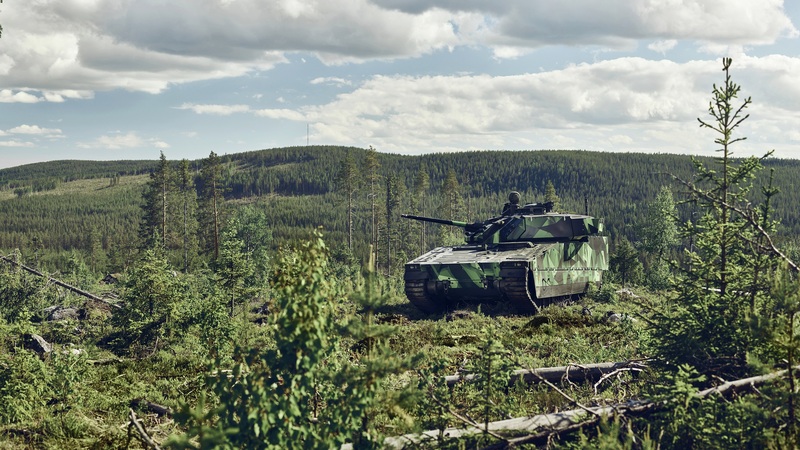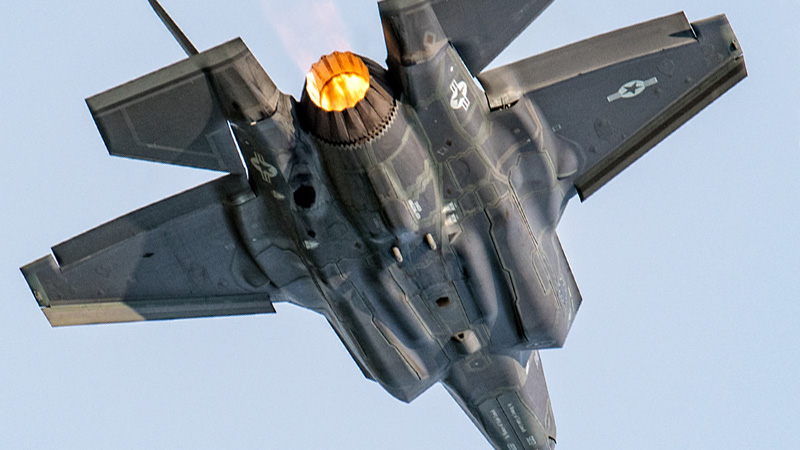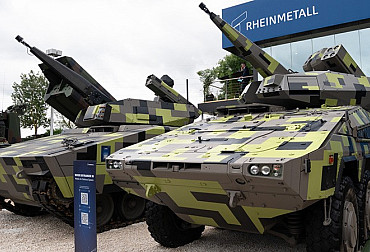The Minister of Defence has cut the Gordian knot - the 7th Brigade battalions can look forward to CV90. The Air Force to F-35
The unravelling of the purchase of tracked IFVs is expected and welcomed by many, yet rather unexpected in the form and speed of the decision. At today's meeting, the Government made a major decision in the area of acquisition and modernisation of the Czech Army. The cabinet decided to cancel the tender for Infantry Fighting Vehicles and subsequently authorised the Minister of Defence, Jana Černochová, to start negotiations with the Swedish Government for the acquisition of CV90 combat vehicles. The signing of the contract for the new IFVs should then take place by autumn next year. The minister has also been given a mandate to negotiate with the US Government on the purchase of F-35 Lightning II multi-role supersonic aircraft. The Czech Army, especially the mechanised battalions of the 7th Mechanised Brigade, should thus receive the Swedish CV90 vehicle from BAE Systems. The Swedes entered the final stage of the tender, which effectively ended after the other bidders rejected the new conditions of the Ministry of Defence, in the role of the favourite. The obvious reason was the success of their bid in Slovakia, and the economic viability of their solution in terms of purchase price was likely from the outset. In the case of the supersonic air force, information confirms that the MoD and the Czech Army prefer to rearm with 5th generation aircraft from the US company Lockheed Martin.
 Picture: At today's meeting, the Government made a major decision in the area of acquisition and modernisation of the Czech Army. The cabinet decided to cancel the tender for Infantry Fighting Vehicles and subsequently authorised defence minister Jana Černochová to start negotiations with the Swedish government for the acquisition of CV90 combat vehicles. The signing of the contract for the new CVVs should then take place by autumn next year. The minister has also been given a mandate to negotiate with the US government on the purchase of F-35 Lightning II multi-role supersonic aircraft. | Jan Zilvar / CZ DEFENCE
Picture: At today's meeting, the Government made a major decision in the area of acquisition and modernisation of the Czech Army. The cabinet decided to cancel the tender for Infantry Fighting Vehicles and subsequently authorised defence minister Jana Černochová to start negotiations with the Swedish government for the acquisition of CV90 combat vehicles. The signing of the contract for the new CVVs should then take place by autumn next year. The minister has also been given a mandate to negotiate with the US government on the purchase of F-35 Lightning II multi-role supersonic aircraft. | Jan Zilvar / CZ DEFENCE
The specific terms and parameters of the acquisition are yet to be specified. Some changes and concessions can be expected, which will allow the final purchase price of the vehicles to stick to the originally intended amount of just under CZK 52 billion incl. This will undoubtedly be spread over several years.
Slovakia recently decided to acquire 152 vehicles of this type, but with a 35 mm gun, and will pay approximately EUR 1.668 billion incl. VAT, i.e. about CZK 42 billion. Slovakia and the Czech Republic will thus join the existing seven users of this type (Sweden has over 500 units, Finland, Norway and Estonia about 100 each, Denmark 45, the Netherlands 150 and Switzerland nearly 200) and can benefit from their experience and mutual support in training and maintenance of the vehicles during their life cycle.
 Picture: The Czech Army, especially the mechanized battalions of the 7th Mechanized Brigade, will receive the Swedish CV9030CZ vehicle from BAE Systems | BAE Systems
Picture: The Czech Army, especially the mechanized battalions of the 7th Mechanized Brigade, will receive the Swedish CV9030CZ vehicle from BAE Systems | BAE Systems
Unlike the Slovaks, who have chosen the 35mm gun variant, the Army will rationally stick to the 30mm calibre from a logistical point of view, and the wheeled (Pandur II) and tracked (CV90) platforms will thus share the same type of ammunition (30x173mm NATO) and the same weapon, the Mk44 Bushmaster II.
The competition for tracked IFV has been running in the Czech Republic since March 2019 and has seen a number of delays and postponements. It was fundamentally complicated, as many expected, by last year's parliamentary elections and the change of government. After the elections, on the recommendation of an expert committee, Defence Minister Metnar eliminated the bids of all three bidders, but did not terminate the competition. The reason for this was incomplete bids - none of the bidders had sufficiently thoroughly dealt with filling in the answers to 9,000 questions concerning all the bid's requirements. The deficiencies were in the order of dozens, i.e. a relatively very small number.
The tender was de facto suspended and a decision by the new Minister of Defence was awaited. Jana Černochová first commissioned Havel & Partners to prepare a legal analysis of the state of the contract, and after its evaluation a decision was taken to modify the conditions. In the first place, there was a requirement that all three bidders explicitly agree to the new conditions, otherwise the tender would be cancelled. This is what happened when GDELS and Rheinmetall rejected the modified tender conditions.
It was widely expected that all three manufacturers (and possibly others - there was speculation about the possibility of PSM returning with the Puma vehicle) would be approached, and a simplified selection process based on the modified requirements, at the end of which negotiations for an intergovernmental agreement and the purchase of vehicles by the selected supplier would be initiated. Instead, Minister Černochová, undoubtedly impressed by the parameters of BAE Systems' original September offer and the progress and outcome of the Slovak acquisition, decided to open negotiations with the company.
The result of the acquisition of tracked IFVs may also foreshadow to some extent the future purchase of 120 mm calibre self-propelled mortars. Currently, the Army has a PRÁM-S tracked vehicle on a BVP-1 chassis. It has not yet been decided whether the new weapon should be on a wheeled or tracked chassis, but given the differences between the 4th Rapid Deployment Brigade and the 7th Mechanised Brigade, it cannot be ruled out that two different platforms will be acquired - a wheeled one for the 4th Mechanised Brigade and a tracked one for the 4th Mechanised Brigade. Rapid Deployment Brigade (logically on a KBVP Pandur II chassis) and a tracked one for the 7th Mechanised Brigade (here, based on similar logic, it could be a vehicle on a CV90 chassis - i.e. a Swedish Grkpbv 90 Mjölner self-propelled mortar).
CV90s will serve in the Czech Armed Forces for at least 20, but more likely 30 years or more. In any case, the speed with which the Minister of Defence proceeded to address the essentially late-started and disproportionately prolonged modernisation of the armament of the mechanised battalions of the 7th Brigade is a surprise. And it is a positive one. Simplifying it, we can say: all we really needed to do was to want to, simplify the process and select the contractors. Take on the responsibility of selection, make a decision and provide the Army with what it needs. From a technical and tactical standpoint, the 7th Brigade could very well use any of the three vehicles on offer. More important from this point of view in future negotiations will be the issue of industrial cooperation in the production and especially maintenance of CV90 vehicles during their life cycle and the way of involvement of Czech defence industry companies in their further modernisation.
"We are pleased with the decision announced today by the Government of the Czech Republic to enter into direct negotiations with the Government of Sweden on the purchase of CV90 vehicles. We believe that the CV90 MkIV is the best possible choice for the Czech Republic and we look forward to welcoming the Czech military to the expanding exclusive user club soon, when they join the 7 other European countries that already have 1,300 vehicles in their fleets in 15 variants.
BAE Systems is ready to support the Czech and Swedish governments in their discussions to ensure the successful delivery of the project. This intergovernmental programme would also bring major benefits to the Czech defence industry. BAE Systems has invested considerable effort in building relationships with Czech industrial partners and many are already part of our supply chain. We now have the opportunity to expand these relationships further."
At the same time, there is an announced shift in another high-profile project. The Ministry of Defence and the Czech Army are favouring a US solution for supersonic aviation, the Lockheed Martin F-35 Lightning II 5th generation aircraft. The plan is to procure 24 aircraft to equip two squadrons and the Czech Air Force will thus join the ranks of a number of allied countries that already have this aircraft in their arsenal, are including it or are seriously considering its acquisition. The parameters of the acquisition and the details of the contract have not yet been specified, and it cannot be but reiterated that this is an extremely ambitious project.
 Picture: The Ministry of Defence and the Army of the Czech Republic prefer the American solution for supersonic aviation, the Lockheed Martin F-35 Lightning II 5th generation aircraft | Shutterstock
Picture: The Ministry of Defence and the Army of the Czech Republic prefer the American solution for supersonic aviation, the Lockheed Martin F-35 Lightning II 5th generation aircraft | Shutterstock
In addition to the financial demands of the purchase, operation and maintenance of the F-35 aircraft, it will necessitate significant changes in logistics facilities, retraining and replenishment of personnel, etc. The step is undoubtedly motivated by the will to strengthen the Czech Republic's transatlantic ties, as the government has declared in its programme statement.
The Ministry of Defence is deciding on a number of major, and also very expensive, acquisition projects in a short time. Betting on the Swedish way in the case of tracked IFV may be, in addition to the result of an objective assessment of the offer (or expected new offer), also a form of "compensation" for Sweden in terms of the decision to rearm the supersonic air force with US F-35 aircraft. Together with the German Leopard 2 A7+ tanks, the Israeli SPYDER anti-aircraft system and the French CAESAR self-propelled howitzers, the Czech Republic will thus rely on suppliers from five countries for the most costly and technologically demanding equipment: the USA (supersonic aircraft and attack and multirole helicopters), Israel (SHORAD), France (guns), Germany (tanks) and Sweden (short-range BMP and air defence systems).





















